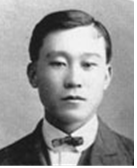His pen name was Haesan (海山). Born in Jaeryeong, Hwanghae Province, he moved to the United States in 1902 with Ahn Chang-ho and founded the Public Association in 1904. In November 1905, he established and became the publisher of the official newspaper, the Public Newspaper. When the New Korea Society was founded in Seoul in April 1907, he joined this organization. He was one of four Korean representatives who protested against Stevens’ remarks.
In 1909, he organized the Korean National Association and served as its president, changing the Public Newspaper to the New Korean Newspaper. In April of that year, he traveled to Vladivostok, Russia, with Lee Sang-seol, who was a special envoy to The Hague, to assist the “Korean National Association in Exile.” In October 1909, when the plan to assassinate Ito Hirobumi was established at the Daedong Public Relations Office, he supported Ahn Jung-geun. Just before the March 1st Movement in 1919, he signed the Korean Declaration of Independence in Manchuria and Noryeong.
He actively supported the organization of the “Independence Women’s Association” in Russia and served as a military committee member of the Korean Socialist Party, working tirelessly to organize and lead the Korean guerrilla units in the Seocheong area until the end. He died from harsh conditions and requested that his body be cremated. The guerrilla fighters honored his wish by cremating him in a log fire, and the site was commemorated as Jeong Jae-gwan Hill. In 1990, he was posthumously awarded the Order of National Foundation for his patriotism.

Leave a Reply